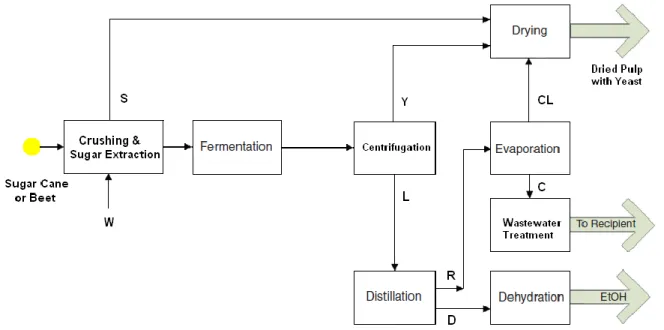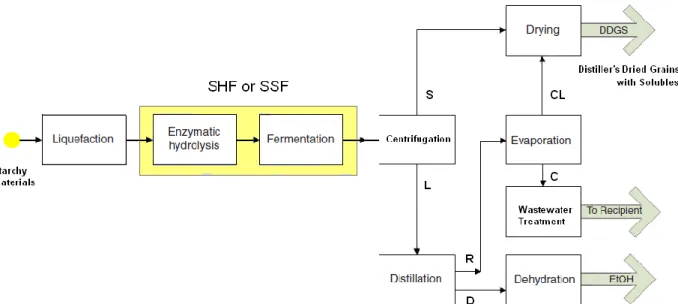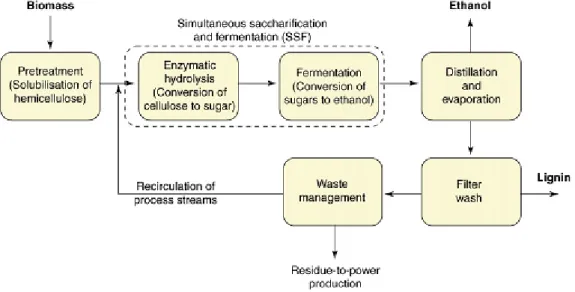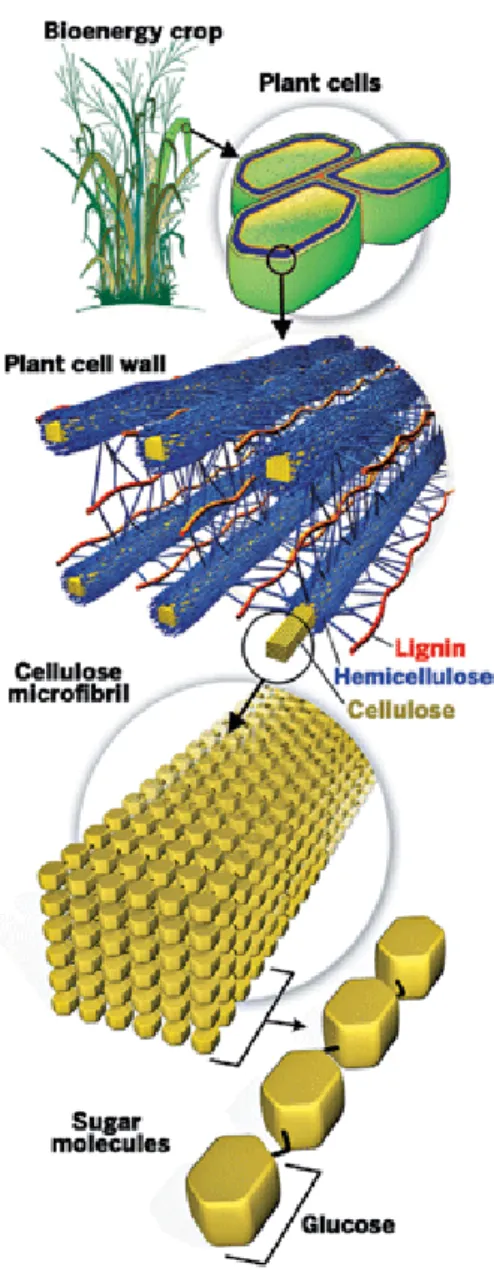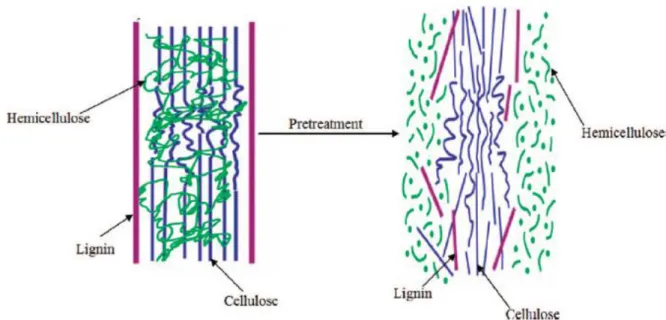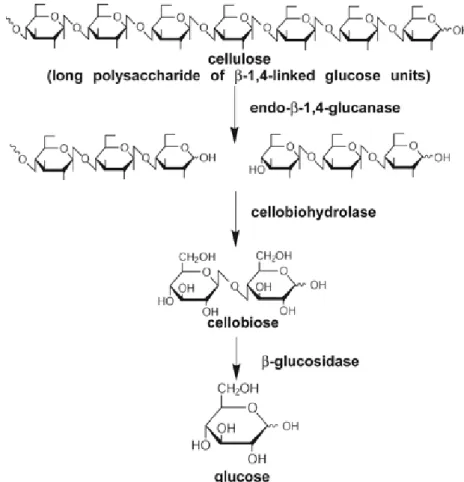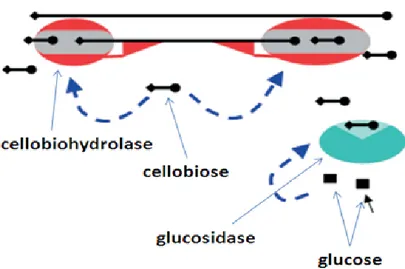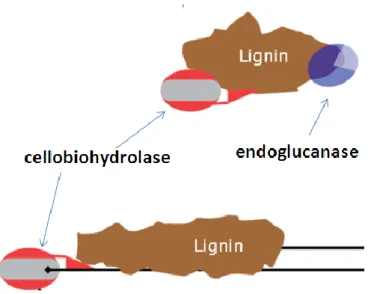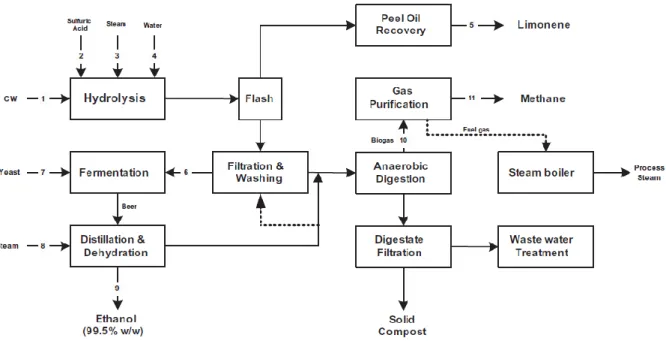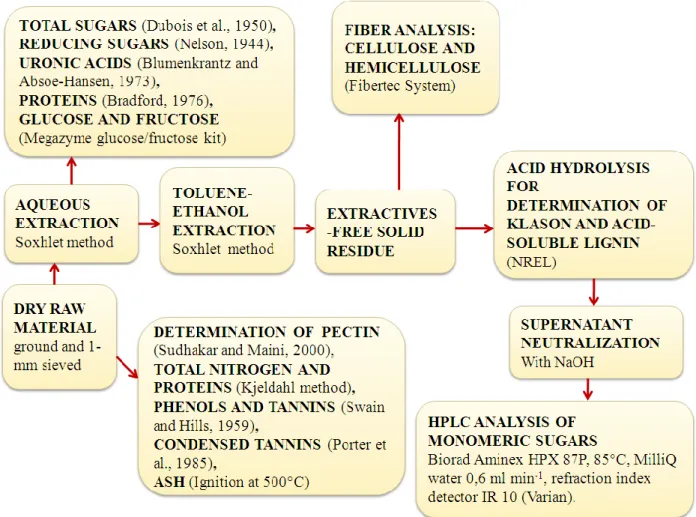UNIVERSITY OF TUSCIA - VITERBO
DEPARTMENT FOR INNOVATION IN BIOLOGICAL, AGRO-FOOD
AND FOREST SYSTEMS (DIBAF)
PhD course
FOOD BIOTECHNOLOGY - CYCLE XXIV
SECOND GENERATION BIOETHANOL
PRODUCTION FROM ORANGE PEEL WASTE
(BIO/19)
Coordinator
PhD Student
Prof. Marco Esti
Guglielmo Santi
Tutor
II
Colgo questa occasione per ringraziare la dott.ssa Silvia Crognale
che, in qualità di tutor, ha saputo guidarmi sapientemente sia nelle attività di
laboratorio che nella stesura dell’elaborato finale:la sua competenza mi è stata
molte volte di grande aiuto.
Grazie anche al prof. Maurizio Petruccioli, per avermi accolto con entusiasmo nel
suo gruppo di ricerca, e al dott. Alessandro d’Annibale, per la sua disponibilità e
per i preziosi suggerimenti che in mille occasioni ha saputo darmi.
Un sincero riconoscimento va anche al prof. Mauro Moresi per aver messo a mia
disposizione il prototipo da lui progettato per il pretrattamento delle biomasse,
rendendo possibile la realizzazione di questo progetto.
Voglio approfittare per ringraziare, inoltre, il gruppo di ricerca di genetica
forestale dell’IBAF CNR di Porano, composto da Fiorella Villani, Claudia
Mattioni, Marcello Cherubini e Daniela Taurchini: presso il loro laboratorio,
ormai quasi sette anni fa, ho svolto il mio primo tirocinio e da quel momento sono
divenuti per me un importante punto di riferimento.
Ringrazio anche la prof.ssa Anna Maria Garzillo, che mi ha fatto da relatore alla
tesi triennale e da controrelatore alla specialistica: con lei ho instaurato un
sincero rapporto di amicizia e stima reciproca e da lei sono sempre stato
incoraggiato a portare avanti i miei obiettivi senza arrendermi di fronte alle prime
difficoltà.
Grazie anche a tutti i colleghi, divenuti anche amici, con cui ho avuto il piacere di
condividere il laboratorio di microbiologia nel corso di questi tre anni, e che
hanno reso più sopportabili anche le giornate più faticose: grazie a Viviana,
Stefano, Tatiana, Salvador, Lorena e Csongor.
Un ringraziamento speciale, infine, va alla mia famiglia e a tutte le persone che,
fuori e dentro l’università, non mi hanno mai fatto mancare il loro sostegno:
grazie in particolare ad Andrea, Fabiana, Simona, Alessandra, Francesca, Anita e
Lorenza.
III
«Ci sono soltanto due possibili conclusioni: se il risultato conferma le ipotesi,
allora hai appena fatto una misura; se il risultato è contrario alle ipotesi, allora
hai fatto una scoperta.»
IV
INDEX
Extended abstract
………... VIIRiassunto
... XI1. Introduction
…...………... 12. State of the art
……… 42.1 Valorization of food industry residues
.………... 52.1.1 Separation or extraction of chemical products
………... 52.1.2 Feedstocks for biotechnological processes
……….. 62.1.3 Bioenergy source
………... 62.2 Food-processing lignocellulosic wastes: a unique source
... 72.2.1 Bioadsorption
……….. 72.2.2 Pectin extraction
………... 82.2.3 Enzymes production
……….. 92.2.4 Antioxidant production
………... 102.2.5 Biofuels production
……… 112.2.5.1 Biochar
……...………... 122.2.5.2 Bio-oil
……… 122.2.5.3 Biogas
……… 122.2.5.4 Biohydrogen
……… 132.2.5.5 Bioalcohols
……….. 142.3 Bioethanol
…...……… 142.3.1 First-generation bioethanol
………..… 142.3.2 Second-generation bioethanol
………. 172.3.2.1 The structure of lignocellulose
………... 192.3.2.2 Pretreatment technologies
………... 212.3.2.3 Formation of inhibitors
……… 282.3.2.4 Enzymatic hydrolysis: the enzyme system
………... 312.3.2.5 Enzymatic hydrolysis: factors of influence
……….. 332.3.2.6 Fermentation: microorganisms and their abilities
……… 37V
2.4 Bioethanol production from food-processing
lignocellulosic residues
……… 392.4.1 Olive pulp
………. 392.4.2 Sugarbeet pulp
………. 422.4.3 Sugarcane bagasse
……….. 432.4.4 Grape pomace
……….. 442.4.5 Banana peels
……… 452.4.6 Corncobs
………... 462.4.7 Orange peel waste
……….. 47
3. Aims of the study
………. 554. Materials and Methods
………... 584.1 Raw Materials
……….. 594.2 Compositional analysis of the feedstocks
……… 594.3 Steam explosion pretreatment of orange peel waste
………… 604.3.1 Description of the apparatus
……… 604.3.2 Operating procedure
……….. 644.4 Enzymatic hydrolysis of steam-treated
orange peel waste residual solids
…..……… 644.5 Repeated-batch fermentation of the hydrolyzates
………. 654.6 Analytical methods
……… 664.6.1 Reducing sugars
……….………. 664.6.2 Total sugars
... 674.6.3 Glucose and fructose
………. 674.6.4 Galactose
……….. 684.6.5 Uronic acids
………. 694.6.6 Proteins
………. 694.6.7 Cellulose, hemicellulose and lignin (NDF, ADF, ADL)
……..……… 694.6.8 Total monosaccharides
……….. 714.6.9 Pectin
………. 714.6.10 Phenols and tannins extraction
………. 724.6.11 Phenol determination
………..……… 72VI
4.6.13 Total nitrogen
……… 734.6.14 Galacturonic acid
………. 744.6.15 Degradation products resulting from the pretreatment
……….. 744.6.16 Cellulase activity
……….. 744.6.17 Ethanol
……… 754.7 Statistics
……… 75
5. Results and discussion
………. 765.1 Chemical characterization of the feedstocks
………. 775.1.1 Main chemical composition
………. 775.1.2 Characterization of the aqueous extractives
……… 795.1.3 Determination of monomeric sugars in extractives-free materials
… 805.2 Autoclave and steam-explosion pretreatments
of orange peel waste
……….. 815.2.1 Time course of the steam explosion pretreatment
……….. 845.2.2 Analysis of the acidic liquors resulting from ACSE
and autoclave pretreatments
………... 865.3 Enzymatic hydrolysis of OPW in shaken flasks
……….. 915.3.1 Effect of enzyme loading on non-pretreated
and autoclave pretreated OPW
……….. 915.3.2 Effect of solid loading on OPW pretreated
in autoclave under mildly acidic conditions
………... 935.3.3 Enzymatic hydrolysis of ACSE pretreated OPW
………... 955.4 Fermentation of OPW hydrolyzates in shaken flask
………... 985.5 Scaling-up experiment
………. 1015.5.1 ACSE pretreatment at triple solid concentration
……… 1015.5.2 Enzymatic hydrolysis in 7-L bioreactor
………... 1025.5.3 Repeated-batch fermentation at bioreactor scale
……… 105
6. Conclusions and future perspectives
……….. 114
7. References
……….. 117
Appendix
………... 141VII
Extended abstract
In the EU, food industry generates a product volume of about 620 x 106 MT each year (Mahro & Timm, 2007) and an amount of wastes of about 175 x 106 MT each year (Awarenet, 2004).
These wastes pose increasing pollution problems and represent a loss of valuable biomass and nutrients. In the past they have generally been dumped (Marriott & Gravani, 2008) or used as such for animal feed or as fertilizers. Regrettably, the decline of the livestock farming in industrialized countries disfavors such end use (Mahro & Timm, 2007). In the last few years, owing to the increasing efforts to prevent environmental pollution, as well as to the economic and energetic concerns, new methods and policies have been introduced in the recovery, bioconversion, and utilization of the valuable constituents present in food processing wastes. Lignocellulosic fiber materials, in particular, represent the most abundant fraction of the biogenic wastes of food industry and may be used for a wide variety of applications (Laufenberg et al., 2003).
The present PhD thesis was aimed at assessing the feasibility of the second generation bioethanol production from a few food-processing lignocellulosic residues.
To this purpose, three residues widely produced in the Mediterranean area (orange peel waste, olive pomace and grape pomace) were chemically characterized to select the most suitable one for bioethanol production. Orange peel waste (OPW) appeared to be the most promising matrix, the total fermentable sugars amounting up to about 48% of dry matter and being associated with low amounts of lignin, phenols, and xylose.
Similarly to other lignocellulosic materials, also the structure of OPW polysaccharides is to be preliminary opened so as to make the polysaccharides more accessible to a cellulolytic enzyme pool. In this study, a novel lab-scale direct steam injection apparatus (DSIA) was used to perform an acid-catalyzed steam-explosion (ACSE) pretreatment. Based on previous literature data, four temperature-time conditions were used, that is 200 °C for 90 s; 180 °C for 150 s; 160 °C for 240 s; and 130 °C for 500 s. Acid and solid concentrations were set to 0.5% v/v and 160 g L-1, respectively.
Differently from the conventional lab-scale high-pressure/high-temperature reactors, requiring a too long heating time (even longer than 60 min if the reaction temperature is higher than 175 °C) and leading to extensive degradation of free sugars, the novel lab-scale direct steam injection apparatus (DSIA) used in this study was able to pre-heat the acidic liquid-solid mixture in times of a few seconds. This allowed a stricter control of the pretreatment conditions (temperature and time) in view of their transfer to pilot- and industrial-scale plants. Moreover, its operation
VIII
minimized the amounts of raw materials necessary for testing quite accurately numerous combinations of the operating variables. The performance of the ACSE pretreatments was also compared with that of the pretreatment performed in a conventional autoclave at 130 °C for 1 h. The four acid-catalyzed steam-explosion (ACSE) conditions tested here gave similar results in terms of sugars released and solid solubilization. Some differences were observed in the amount of inhibitors produced, even if these values resulted to be always below the tolerance threshold of the yeast strain used. The most significant difference was that the ACSE conditions at 200 °C for 90 s and 180 °C for 150 s led to a pectin solubilization of about 73%, this value being quite higher than that obtained either in the other ACSE conditions or in the autoclave, with a positive effect on the subsequent enzymatic hydrolysis step.
Some preliminary enzymatic hydrolysis experiments for cellulose depolymerization were carried out in the shaken-flask scale by suspending non-pretreated or autoclave-pretreated (under neutral or mildly acidic conditions) OPW in the liquid (i.e., sodium acetate buffer) recommended for the commercial cellulase preparation used in this study. In this way, it was possible to assess the need of an acidic pretreatment to improve depolymerization, given the discordance in the literature reports, as well as to identify the best cellulase dosage and solid loading. A mild acidic pretreatment was appropriate for the subsequent depolymerization, whereas an enzyme dose of 6 FPU cellulase g-1 cellulose represented the best compromise between the needs of yield maximization and cost minimization in view of a scaling-up of this process. The glucose yield was the highest at a solid loading of 5 or 10% (w/v), but tended to decrease slightly when the latter was increased up to 20%. Anyway, at the highest solid concentration, glucose concentration in the liquor after saccharification was also the highest one, this being advantageous for the ultimate ethanol recovery by distillation.
Such optimal values of enzyme (6 FPU cellulase g-1 cellulose) and solid (20% w/v) loadings were successfully used to saccharify the ACSE-pretreated OPW residual solids. Actually, the enzymatic hydrolysis performed by suspending the OPW residual solids after ACSE-pretreatment at 200 °C for 90 s in sodium acetate buffer succeeded in releasing 59% of theoretical glucose, this yield being quite higher than that (40%) achieved starting with the OPW residual solids pretreated in the autoclave at 130 °C for 1 h. A similar yield (59%) was also obtained when the former ACSE-pretreated OPW residual solids were re-suspended in their own acidic liquor, so as to utilize even the free-sugar fraction and achieve a higher sugar concentration in view of its conversion into ethanol. Thus, this condition was used for the depolymerization of the remaining ACSE-pretreated solids.
IX
Enzymatic hydrolysis of OPW deriving from pretreatment at 180 °C-150 s and 200 °C-90 s gave the highest glucose yields of about 57%, their difference being statistically insignificant, probably as the result of the highest percentage of pectin solubilization achieved after these pretreatments. Nevertheless, the depolymerization of solids pretreated at 180 °C was faster than that of solids pretreated at 200 °C, this suggesting that the lower temperature-longer time pretreatment led to a more profound destruction of the lignocellulosic crosslinks.
Fermentability of hydrolyzates resulting from ACSE pretreatments and enzymatic hydrolysis was evaluated in the shaken-flask scale under repeated-batch conditions using the industrial strain Saccharomyces cerevisiae F15. All the hydrolyzates were efficiently fermented and the highest ethanol yield and productivity were 49.48% (the theoretical value being about 51%) and 4.85 g L-1 h-1, respectively. However, no direct correlation between pretreatment conditions and fermentative performances was assessed.
To scale-up the previous results, a new ACSE trial at 180 °C for 90 s was performed by tripling the solid loading, and then submitting the resulting slurry to enzymatic hydrolysis in a 7-L stirred bioreactor, while the repeated batch fermentation was carried out in a 1-L bioreactor.
ACSE pretreatment at 180 °C for 90 s and solid loading of 480 g L-1 gave a lower percentage of released glucose and fructose and a higher percentage of inhibitors, in comparison with the same pretreatment performed at a solid loading of 160 g L-1. The lower efficacy of pretreatment at a triple solid loading was counterbalanced by the subsequent enzymatic hydrolysis performed in a 7-L STR reactor. Since most of the pectin was still present in the solid, in this saccharification trial the cellulase preparation was integrated with a commercial pectinase one. In this way, 69.5% release of the theoretical glucose and fructose was obtained, this yield being higher than that (67.8%) obtained in the shaken-flask scale when using the same ACSE-pretreated solids at a density of 160 g L-1.
By transferring the fermentative process from shaken-flasks to a 1-L stirred bioreactor, a slight decrease in ethanol productivity (from 4.85 to 4 g L-1 h-1) was observed, probably because of the higher concentration of inhibitors. Differently from productivity, maximum ethanol yield did not differ, being always close to the theoretical value.
Considering the total amount of fermentable sugars obtained through the optimized ACSE pretreatment and the subsequent enzymatic hydrolysis, the overall ethanol yield of the repeated batch process from OPW in 1-L bioreactor was 41.5%.
In conclusion, on the basis of a mass balance including all the glucose and fructose (11.13% dm) released after pretreatment at 180 °C for 150 s with a solid loading of 480 g L-1 and the glucose freed after enzymatic hydrolysis (17.86% dm), and accounting for an overall ethanol yield of
X
41.5%, the overall process yield at 1-L STR reactor scale would amount to about 153 L bioethanol per metric ton dry OPW.
XI
Riassunto
All‟interno dell‟Unione Europea, l‟industria alimentare genera ogni anno una produzione di circa 620 milioni di tonnellate (Mahro & Timm, 2007). Di questa attività gli scarti raggiungono i 175 milioni di tonnellate (Awarenet, 2004).
Questi rifiuti costituiscono un problema di inquinamento sempre crescente e si configurano come una perdita considerevole di biomassa e sostanze nutritive. In passato la soluzione più utilizzata è stata il conferimento in discarica (Marriott & Gravani, 2008); l‟alternativa era l‟uso di questi rifiuti come fertilizzanti o come mangimi animali. Tuttavia, questo utilizzo è limitato dal declino dell‟allevamento nei paesi industrializzati (Mahro & Timm, 2007). Negli ultimi anni, grazie agli sforzi sempre maggiori per prevenire l‟inquinamento ambientale e alle crescenti preoccupazioni economiche ed energetiche, sono stati introdotti nuovi metodi per il recupero, la bio-conversione e l‟utilizzo delle componenti valorizzabili degli scarti dell‟industria alimentare. In particolare, i materiali fibrosi lignocellulosici rappresentano la più importante frazione dei rifiuti del ciclo industriale alimentare e potrebbero essere utilizzati in un‟ampia varietà di applicazioni (Laufenberg et al., 2003).
La presente tesi di Dottorato ha come obbiettivo quello di valutare la possibilità di produrre bioetanolo di seconda generazione a partire da residui lignocellulosici dei processi industriali agro-alimentari.
A tale scopo, per trovare il substrato più adatto alla produzione di bioetanolo, sono stati caratterizzati chimicamente tre rifiuti largamente prodotti nell‟area mediterranea: il pastazzo di arance, la sansa di olive e le vinacce. Dagli esperimenti effettuati, il pastazzo di arance (OPW) è risultato essere il più promettente tra questi. Infatti in questa matrice il totale degli zuccheri fermentabili ammontava a circa il 48% della materia secca, con basse percentuali di lignina, fenoli e xilosio.
Come per gli altri materiali lignocellulosici, anche l‟OPW richiede un pretrattamento per rendere più accessibile la struttura dei polisaccaridi alle cellulasi.
Durante questo studio è stato utilizzato un prototipo a iniezione di vapore su scala di laboratorio (DSIA), per effettuare un pretrattamento di steam-explosion in ambiente acido (ACSE). Sulla base dei dati bibliografici disponibili, sono state applicate quattro differenti condizioni di temperatura-tempo: 200 °C per 90 s; 180 °C per 150 s; 160 °C per 240 s; 130 °C per 500 s. La concentrazione di acido ed il carico di solido sono state fissate a 0.5% v/v e 160 g L-1.
I normali reattori su scala di laboratorio che utilizzano elevate temperature/pressioni, richiedono un lungo tempo di riscaldamento (che può superare i 60 min nel caso di temperature superiori ai
XII
175 °C). Questo fattore porta ad una estensiva degradazione degli zuccheri. Il nuovo apparato a iniezione di vapore (DSIA) ha bisogno al contrario di pochissimi secondi per raggiungere la temperatura richiesta e ciò permette un controllo serrato delle condizioni di pretrattamento (temperatura e tempo), necessario in un processo su scala industriale. Inoltre, comparato a un impianto industriale, il nostro sistema richiede una minore quantità di materiale per ogni esperimento: questo permette di testare un maggior numero di combinazioni delle diverse variabili.
I pretrattamenti di steam-explosion sono stati comparati a pretrattamenti eseguiti in un‟autoclave convenzionale a 130 °C per 1 h.
Le quattro condizioni di steam-explosion testate in questo studio hanno dato risultati simili in termini di zuccheri rilasciati e di solubilizzazione del solido. Alcune differenze sono state osservate nella quantità di inibitori prodotti, sebbene questi valori siano comunque al di sotto della soglia di tolleranza del lievito Saccharomyces cerevisiae. L‟osservazione più importante è stata effettuata durante gli esperimenti alle temperature più alte (200 °C-90 s e 180 °C-150 s), quando si è raggiunta la più alta solubilizzazione della pectina (73.11% della quantità iniziale), con effetti positivi nella successiva fase di idrolisi enzimatica.
Alcuni esperimenti preliminari di idrolisi enzimatica per depolimerizzare la cellulosa sono stati eseguiti in beuta agitata, in tampone sodio acetato (che era la fase liquida consigliata per la cellulasi commerciale utilizzata in questo studio), su OPW non pretrattato e pretrattato in autoclave (in condizioni neutre o blandamente acide). Questa procedura è stata utilizzata per verificare l‟utilità di un pretrattamento acido per migliorare la depolimerizzazione (considerata la discordanza presente in letteratura) e allo stesso tempo per definire il miglior carico di cellulasi e di solido. Gli esperimenti hanno evidenziato che le condizioni migliori di pretrattamento per la successiva depolimerizzazione erano quelle blandamente acide. Inoltre 6 FPU di cellullasi g-1 di cellulosa si configura come il miglior compromesso tra le necessità di massimizzazione della resa e di abbattimento dei costi in vista di uno scaling-up del processo. Per quanto riguarda il carico di solido, la resa più alta in glucosio è stata ottenuta al 5 e al 10 % (p/v), con un piccolo decremento dal 10 al 20%. In ogni caso, la più alta concentrazione di solido utilizzata (20%) ha dato la più alta concentrazione di glucosio. Questo rappresenta un importante vantaggio, dal momento che nella fase fermentativa potrà essere ottenuta un‟alta concentrazione di etanolo, cosa che faciliterebbe la distillazione finale.
Il carico di enzima ottimizzato durante gli esperimenti preliminari (6 FPU di cellullasi g-1 di cellulosa), è stato adoperato anche nei campioni di OPW pretrattati con steam-explosion, utilizzando il carico di solido (20% p/v) che rendeva massima la concentrazione di glucosio nel
XIII
liquido ottenuto. L‟idrolisi enzimatica – eseguita su tampone sodio acetato – su OPW pretrattato con steam-explosion a 200 °C per 90 s, ha dato una resa in glucosio (59% dello zucchero potenzialmente rilasciabile) molto più alta se paragonata all‟idrolisi realizzata su OPW pretrattato in autoclave in condizioni blandamente acide (40%). Un risultato simile è stato ottenuto quando l‟OPW, pretrattato a 200 °C per 90 s, è stato risospeso nel liquido acido di pretrattamento anziché nel tampone sodio acetato, con il vantaggio che, nel secondo caso, gli zuccheri rilasciati dopo il pretrattamento di steam-explosion sono stati recuperati. In base a questi dati, questa condizione è stata utilizzata per la depolimerizzazione dei rimanenti solidi pretrattati con steam-explosion.
L‟idrolisi enzimatica dell‟OPW pretrattato a 180 °C-150 s e a 200 °C-90 s, ha dato le più alte rese di glucosio, raggiungendo un valore medio pari a circa il 57%, senza differenze statisticamente significative tra i due dati. Questo risultato potrebbe essere spiegato con la maggiore percentuale di solubilizzazione della pectina che era stata ottenuta dopo questi pretrattamenti, rispetto a quelli eseguiti a temperature più basse. Tuttavia, il solido pretrattato a 180 °C è stato depolimerizzato più velocemente di quello pretrattato a 200 °C: ciò suggerisce che una minore temperatura ed un più breve tempo di pretrattamento portano ad una più profonda distruzione dei legami incrociati della lignocellulosa.
La fermentabilità degli idrolizzati ottenuti dai pretrattamenti di steam-explosion seguiti da idrolisi enzimatica è stata valutata in beuta agitata in condizioni di batch ripetuto usando il ceppo industriale Saccharomyces cerevisiae F15. Tutti gli idrolizzati sono stati efficacemente fermentati: la resa più alta di etanolo è stata del 49.48% (su un valore teorico del 51%) e di 4.85 g L-1 h-1. Tuttavia, non è stata individuata alcuna correlazione diretta tra le condizioni di pretrattamento e le performance di fermentazione.
Per uno scale up del processo, è stato eseguito un nuovo pretrattamento di steam-explosion a 180 °C per 90 s, triplicando il carico del solido. Il pretrattato è stato sottoposto ad un‟idrolisi enzimatica in un bioreattore da 7 L, mentre la fermentazione in bacht ripetuto è stata effettuata in un bioreattore da 1 L.
Il pretrattamento con steam-explosion a 180 °C per 90 s di un carico di solido di 480 g L-1, ha rilasciato una minore percentuale di glucosio e fruttosio ed una maggiore percentuale di inibitori, rispetto allo stesso pretrattamento effettuato con un carico di solido di 160 g L-1. La minore efficacia del pretrattamento a tripla concentrazione è stata controbilanciata dalla successiva idrolisi enzimatica eseguita in un reattore STR da 7 L. Poiché l‟analisi del liquido di pretrattamento dimostrava che la maggior parte della pectina era ancora presente nel solido, in questo esperimento alla cellulasi è stata abbinata una pectinasi commerciale. Alla fine del
XIV
pretrattamento di steam-explosion a tripla concentrazione e della successiva idrolisi enzimatica, è stato ottenuto il 69.52% del glucosio e del fruttosio potenzialmente rilasciabili. Questo valore risulta essere più alto di quello ottenuto con pretrattamento con steam-explosion a 160 g L-1, seguita da un‟idrolisi enzimatica in beuta agitata (67.8%).
Il trasferimento del processo fermentativo dalla beuta agitata ad un reattore STR da 1 L ha portato ad una leggera diminuzione della produttività di etanolo (da 4.85 a 4 g L-1 h-1). Questo risultato può essere ascritto all‟aumento degli inibitori prodotti dopo il pretrattamento con steam-explosion a triplo carico di solido, comparato a quello a 160 g L-1. A differenza della produttività, la massima resa in etanolo non è cambiata con l‟aumento di scala, rimanendo vicina alla resa teorica della fermentazione alcolica. Considerando la quantità totale di zuccheri fermentabili ottenuti attraverso il pretrattamento con steam-explosion ottimizzato e la successiva idrolisi enzimatica, la resa complessiva di etanolo da OPW in un bioreattore da 1 L è stata del 41.52%.
In conclusione, sulla base di un bilancio di massa che include tutto il glucosio ed il fruttosio (11.13% rispetto al peso secco di partenza) rilasciati dopo pretrattamento a 180 °C per 150 s con un carico solido di 480 g L-1, e il glucosio liberato dopo l‟idrolisi enzimatica (17.86% rispetto al peso secco di partenza), e considerando una resa complessiva di etanolo del 41.52%, la resa totale del processo in un reattore STR da 1 L ammonterebbe a circa 153 L di bioetanolo per tonnellata di pastazzo di arance secco.
1
1. INTRODUCTION
2
In the EU, food industry generates a product volume of about 620 x 106 metric tons (MT) each year. Since in most cases only parts of the incoming biomass are actually used for the generation of a particular food product, unavoidable biogenic residues may occur in large quantities during food processing (“product-specific residues”). Although the food industry is a well established industry, it is rather difficult to obtain reliable data on the amounts of waste generated during the various food processing stages. This is due to the fact that either similar waste or by-product fractions are often named and categorized differently or that the production data (incl. waste amounts) are kept confidential (Mahro & Timm, 2007).
The most prominent and detailed analysis of the amount of residues generated in the food processing industry was carried out recently (2001–2004) in the joint European research project Awarenet, in which data from 19 selected different food production processes, including the five main types of food (fish, meat, dairy products, wine and food from vegetables), were analyzed. The analysis is referred to the 15 Eurostat countries and reports an amount of wastes of about 175 x 106 MT each year (Awarenet, 2004).
These wastes pose increasing pollution problems and represent a loss of valuable biomass and nutrients. In the past they have often been dumped. Nowadays, this is no more sustainable since the high amounts of carbohydrates, proteins, fats and mineral salts present in these residues cause the formation of bad smells and water browning. For these reasons, a biological stabilization treatment is required prior to their dumping in the environment (Marriott & Gravani, 2008).
Moreover, Council Directive 1999/31/EC on landfill waste compels member states to reduce biodegradable organic waste in landfills by 65% (as compared to 1995 levels) by no later than 2016 (European Union, 1999).
The most common alternative to their disposal is to use them as such for animal feed or as fertilizers. In particular, the residues generated during starch production, like corn germ meal or corn gluten meal, can be easily sold as an animal feed or feed supplement owing to their nutritional value (Owen & Jajasurya, 1989). Regrettably, the decline of the livestock farming in industrialized countries disfavors such end use (Mahro & Timm, 2007).
In the last few years, owing to the increasing efforts to prevent environmental pollution, as well as to the economic and energetic concerns, new methods and policies have been introduced in the recovery, bioconversion, and utilization of the valuable constituents present in food processing wastes (Laufenberg et al., 2003).
Lignocellulosic fiber materials, in particular, represent the most abundant fraction of the biogenic wastes of food industry and may be used for a wide variety of applications.
3
The present PhD thesis was aimed at improving the process of second generation bioethanol production from food-processing lignocellulosic residues.
Lignocellulosic residues are composed of carbohydrate polymers (mainly cellulose and hemicelluloses), lignin, and a remaining, smaller part, of proteins, acids etc. The majority of the carbohydrates can be hydrolyzed to single sugars and fermented to ethanol. However, in the case of lignocellulose, a particular crosslinking between polysaccharides and lignin creates a barrier to the production and recovery of valuable materials. Thus, the technology used to produce ethanol from this kind of residues is different from the one employed in the conventional starch-to-ethanol industry. An initial pretreatment stage is required to soften the material and break down the lignocellulosic structure in order to make it more susceptible to an enzymatic attack before fermentation (Mtui, 2009). All the pretreatment technologies are usually carried out under severe reaction conditions with a large capital investment, high processing costs and great investment risks (Champagne, 2008; Wheals et al., 1999).
During the high-temperature pretreatment process, degradation compounds are formed from pentoses and hexoses. These components are toxic and can inhibit the succeeding enzymatic and fermentative processes. Therefore, they should be removed or neutralized prior the fermentation. As an alternative, a fermenting organism with high inhibitor tolerance should be used (Palmqvist & Hahn-Hägerdal, 2000a).
After the pretreatment, a consortium of enzymes (endoglucanase, exoglucanase and β-glucosidase) is needed to break down the carbohydrate polymers. Enzymatic hydrolysis can be improved through the optimization of substrate concentration and enzyme dosing (Champagne, 2008).
As for the fermentation, the most frequently used microorganism in industrial processes is Saccharomyces cerevisiae, which has proved to be very robust and well suited to the fermentation of hexose sugars from lignocellulosic hydrolyzates (Hahn-Hägerdal et al., 2006). Generally, economic restrictions force industrial processes to work in a very small range of operating conditions. Thus, it is very important to define the optimum conditions to achieve sufficient profitability.
4
2. STATE OF THE ART
5
2.1 Valorization of food industry residues
The amount of wastes produced from food-processing industries is continuously increasing and poses serious environmental problems. For this reason many research groups are investigating the opportunities for the valorization of such residues.
The different upgrading options for all the food-processing residues are subdivided into three main groups, as briefly described hereafter. In section 2.2 the attention will be focused on a particular category of food-processing residues, that is the lignocellulosic fiber materials: their potential uses will be described in a more detailed manner.
2.1.1 Separation or extraction of chemical products
Several substances may be separated or extracted from such residues, the most interesting being some special high price compounds, such as polyphenols from pomace to be used as antioxidants. Practically, a huge number of special products (e.g., detergents, gelling agents, cosmetic additives, etc.) can be extracted from all fruit, vegetable, meat or fish processing residues (Healy et al., 1994; Schrieber & Seybold, 1993; Louli et al., 2004; Rezzoug & Louka, 2009). Table 2.1 lists some major compounds that may be recovered from the diverse food processing residues.
Table 2.1 Chemical products recovered from food processing residues.
Process residues from Chemical compounds
fish and crustaceans processing collagen, gelatin, chitin, fish oil, polyunsaturated fatty acids
meat processing collagen, gelatin, animal fat, blood plasma milk and cheese production Lactose
wine, coffee and cocoa production
natural pigments, tartaric acid, antioxidants, caffeine, tannins, pectin
fruits and vegetables processing pectin, antioxidants, essential oils, vitamins, lecithin
New additional product lines might be discovered in the future also by applying a more systematic extraction screening for chemical compounds. By applying such a screening approach to cocoa bean shells (a residual waste of chocolate production, generally discarded after thermal treatment), it was possible to extract 4–5 useful products, e.g., polyphenols, a glue, pectins, a pigment, and a flavor (Timm et al., 2006).
6
2.1.2 Feedstocks for biotechnological processes
Alternatively, food-processing residues can be used as fermentation media in biotechnological processes. Corn-steep liquor (deriving from corn after the extraction of starch and oil), molasses (deriving from beet- and sugar-cane after sucrose extraction), and whey (byproduct of cheese production) have been largely used in biotechnology (Gonzales Siso, 1996; El-Abyad, 1992; Lee et al., 2000). Anyway, their use asks for a careful analysis of their composition since both the selected microorganism and process mostly require a very specific nutrient composition (C/N/P balance), including minor components like vitamins. Furthermore, some additional criteria must be met by biomass resources to be used as a chemical feedstock. In particular: - availability and quality of the resource must be reliable;
- chemical composition must be suited for transformation in marketable products;
- price of the raw material, its transport and processing must be competitive (Atkinson & Mavituna, 1991).
2.1.3 Bioenergy source
Food processing residues can also be used for producing energy. However, the comparatively high water content of most of them often prohibits their direct use for thermal energy production. To exploit their energetic potential more efficiently, it is necessary to reduce their initial water content by either drying or pressing. Another option is to convert the moist or liquid biowaste fraction directly by methanization or fermentation, thereby generating energy carriers, like biogas, ethanol or hydrogen (El-Refai et al., 1992; Amartey & Leung, 2000).
The situation is different in the case of solid biomass, that can be converted into more useful forms of energy by a number of different technologies. These conversion technologies can be subdivided into two basic categories, such as thermochemical and biochemical processes. Combustion, carbonization/pyrolysis, gasification and liquefaction are considered as thermo-chemical conversion processes, while biothermo-chemical conversion processes include two process options, that is digestion and fermentation. When the thermochemical processes are applied, liquid products (wood tar, tar, oil, and pyrolytic oil), gas products (wood gas, pyrolytic gas, and hydrogen), and solid products (char, and charcoal) are produced, while the major products of biological conversion processes are biogas, biohydrogen and ethanol (Klass, 1998).
7
2.2 Food-processing lignocellulosic wastes: a unique source
Lignocellulosic fiber materials represent the most abundant fraction of the biogenic wastes of food industry and may be used for a wide variety of applications. This section reports the most interesting options for their valorization.
2.2.1 Bioadsorption
Adsorption is a well-known equilibrium separation process and an effective method for water decontamination. It is generally superior to other techniques for water reuse in terms of initial cost, flexibility and simplicity of design, ease of operation, and insensitivity to toxic pollutants. Moreover, no harmful substances are formed (Aksu & Jener, 2001). Several studies dealt with the application of various food processing lignocellulosic residues to this purpose.
Achak et al. (2009) studied the use of banana peel as a biosorbent for removing phenolic compounds from olive mill wastewaters, by investigating the effect of adsorbent dosage, pH and contact time. By increasing the banana peel dosage from 10 to 30 g L-1, the phenolic compounds adsorption rate significantly increased by 60 to 88%. Increase in the pH to above neutrality resulted in the increase in the phenolic compounds adsorption capacity. Such a matrix was applied to remove industrial dyes (Annadurai et al., 2002). An alkaline pH favored the adsorption of dyes, and intraparticle diffusion of dyes within the particle was identified as the rate limiting step. Memon et al. (2009) described the use of banana peel for the removal of Cr(VI) from industrial wastewater by varying several parameters, such as pH, contact time, initial metal ion concentration, and temperature. The binding of metal ions was found to be pH-dependent with the optimal sorption occurring at pH 2.
Chestnut shells were used to remove selected pesticides, such as carbofuran (CF) and methyl parathion (MP) from aqueous solutions (Zuhra Memon et al., 2008), by studying the effect of a few sorption parameters, such as contact time, pH, temperature, and initial pesticide concentration. Maximum percent. sorption (99±1%) was achieved when treating solutions containing (0.38-3.80)×10-4 and (0.45-4.5)×10-4 mol dm-3 of MP and CF pesticides, respectively, with 4 g L-1 of sorbent at pH 6 for 30 min.
Some food-processing lignocellulosic residues, such as potato peels, coconut shells and hazelnut shells, can also be converted into charcoal or activated carbon and used as biosorbent. Potato peels charcoal (PPC) was tested as an adsorbent of Cu(II) from aqueous solutions by studying the effects of various parameters, such as temperature, pH and solid/liquid ratio. One gram of
8
PPC allowed 99.8% removal of copper(II) from 100 ml of an aqueous solution at pH 6.0 containing 150 mg l−1 of copper (II) under shaking for 20 min (Aman et al., 2008).
Gimba et al. (2009) investigated the adsorption of indigo blue (an industrial dye), lead, cadmium and mercury by activated carbons of different particle size obtained from coconut shells using FeCl3, ZnCl2, CaCl2 and K2CO3 at varying concentrations as activating salts. The 250-μm
particle size was the most effective one in adsorbing indigo blue up to 98% using ZnCl2
-activated carbon, 70% of Pb using FeCl3-activated carbon, and 81 or 83% of Cd or Hg using
K2CO3-activated carbon.
Impregnated activated-carbon prepared from hazelnut shells using sulfur-containing compounds were tested to adsorb mercuric ions from aqueous solutions (Khalkhali & Omidvari, 2005). Milenkovic et al. (2009) observed that the removal of Cu(II) ions from aqueous solutions using a granular activated-carbon obtained from hazelnut shells was higher in the presence of ultrasound than in its absence, but ultrasound reduced the kinetic adsorption rate constant.
Since the production of activated carbon represents an additional cost, Ferrero (2007) attempted to remove Methylene Blue and Acid Blue 25 using ground hazelnut shells as such. The adsorption capacity of hazelnut shells toward Methylene Blue was even higher than that reported for activated carbon obtained from the same raw material.
Dye removal was also performed using untreated olive pomace under different process variables, such as initial pH, biosorbent dosage, contact time, temperature, and ionic strength. The highest dye biosorption capacity observed at pH 2, the time needed to reach the biosorption equilibrium being 40 min with a biosorbent concentration of 3.0 g L-1 (Akar et al., 2009).
The potential of orange peel to remove lead (II) ions from an aqueous solution was investigated by varying the pH, contact time, amount of sorbent and ions concentration. The sorption capacity of orange peel was comparable to that of other available sorbents (Alzaydien, 2009).
Mercapto-acetic acid-modified orange peel was used to adsorb Cu2+ and Cd2+ ions, the corresponding maximum adsorption capacities being 70.67 and 136.05 mg g-1, respectively. Moreover, the biosorbent was used for more than five cycles (Liang et al., 2009).
2.2.2 Pectin extraction
Pectins are complex mixtures of polysaccharides containing units of galacturonic acid as the main chain. These molecules have been isolated and extensively studied from various plant tissues, and are widely used in the pharmaceutical, cosmetic and food industries. Commercial
9
pectins are mostly available from two main sources: apple pomace and citrus peels (Voragen et al., 1995).
Several waste products might be used as unconventional pectin sources.
Emaga et al. (2008) applied a 2n factorial design to study the influence of pH (1.5 and 2.0), temperature (80 and 90 °C) and time (1 and 4 h) on the extraction yield of pectin from banana peels. The factor pH was the most important parameter influencing pectin yield and chemical composition. Lower pH values negatively affected the galacturonic acid content of pectin, but increased the pectin yield.
The revenue for the pectic extraction from olive pomace by a continuous biphasic extraction system was studied by assessing the gelation potential of extracted pectin via rheological methods. It was inferred that olive pomace might be a potential source of gelling pectic materials, with properties quite similar to those of commercial citrus pectin (Cardoso et al., 2003).
2.2.3 Enzymes production
The main limitation for the extensive industrial application of microbial enzymes is their high cost. Therefore, a good strategy to increase the productivity of the fermentation processes would be the optimization of the culture conditions. Since the nutritive substances employed in the culture medium represent a high percentage of the total production costs, the reduction in the substrate expenses would increase the productivity of the process (Gomez et al., 2005). The composition of food-processing lignocellulosic wastes is usually rich in sugars which, due to their organic nature, are easily assimilated by microorganisms. This makes them very suitable as raw materials for the microbial production of secondary metabolites of industrial significance, such as enzymes (Rodrìguez Couto et al., 2002).
Among the processes used for enzyme production, solid state fermentation (SSF), defined as „„the growth of microorganisms (mainly fungi) on moist solid materials in the absence of free-flowing water‟‟ (Perez-Guerra et al., 2003), is an attractive one because it presents higher productivity per reactor volume, lower capital and operating costs, lower space requirements, simpler equipment and easier downstream processing with respect to submerged fermentation (SmF) (Pandey et al., 2000a). Some examples of this process applied to food processing lignocellulosic residues are reported below.
Sugar-cane bagasse has been extensively studied for the production of cellulases, laccases and xylanases. Roussos et al. (1992) used a mixture of bagasse and wheat bran (4:1) for the
10
production of cellulases. They suggested hydraulic pressing as a good technique to leach out the enzymes from the fermented matter. Modi et al. (1994) reported higher yields of cellulase from a strain of Streptomyces sp. HM29 when grown on bagasse instead of rice straw, rye straw or corncobs. An extensive study was carried out by Pal et al. (1995) on SSF of sugarcane bagasse using a strain of mushroom fungus and another of white-rot fungus, separately, for 40 days. Trametes versicolor produced laccase and manganese-peroxidase activities, while only laccase activity was found with Flammulina velutipes. Jain (1995) obtained a high xylanase activity using the thermophilic fungus Melanocarpus albomyces IIS-6 on sugarcane bagasse.
Mamma et al. (2008) investigated the production of multienzyme preparations containing pectinolytic, cellulolytic and xylanolytic enzymes by some mesophilic fungi. Under optimal conditions Aspergillus niger BTL resulted to be by far the most potent strain in polygalacturonase and pectate lyase production, followed by Fusarium oxysporum F3, Neurospora crassa DSM 1129 and Penicillium decumbens. N. crassa DSM 1129 produced the highest endoglucanase activity and P. decumbens the lowest one. Comparison of xylanase production revealed that A. niger BTL produced the highest activity followed by N. crassa DSM 1129, P. decumbens and F. oxysporum F3. N. crassa DSM 1129 and P. decumbens did not produce any b-xylosidase activity, while A. niger BTL produced approximately 10 times more β-xylosidase than F. oxysporum F3. The highest invertase activity was produced by A. niger BTL while the lowest ones by F. oxysporum F3 and P. decumbens.
Osma et al. (2007) studied the potential of banana skin as a support-substrate for the production of extracellular laccase by the white-rot fungus Trametes pubescens CBS 696.94, the maximum activity of laccase being 1570 U/l.
Gomez et al. (2005) assessed the potential of two lignocellulosic wastes, chestnut shell and barley bran, for laccase production by the white-rot fungus Coriolopsis rigida under solid-state conditions. Barley bran induced the highest laccase activities (3x105 nkat L-1), about 25-fold higher than the value attained in the chestnut-shell cultures.
2.2.4 Antioxidant production
Increasing interest to replace synthetic antioxidants has led to screen natural sources of antioxidants, especially plant materials. Flavonoids and other polyphenols possess anti-tumoral, anti-allergic, anti-platelet, anti-ischemic, and anti-inflammatory activities, among others, and most of these effects are believed to be due to their antioxidant capacity. Phenolic compounds in edible and non-edible plants have been reported to have antioxidant capacity. Several types of
11
plant materials (such as vegetables, fruits, seeds, hulls, wood, bark, roots and leaves, spices and herbs, etc.) have been examined as potential sources of antioxidant compounds. These could be used for increasing the stability of foods by preventing lipid peroxidation and also for protecting oxidative damage in living systems by scavenging oxygen radicals (Moure et al., 2001).
Gonzales-Montelongo et al. (2010) optimized the extraction conditions to maximize the antioxidant activity of banana-peel extracts. An aqueous solution of acetone yielded extracts with high antioxidant capacity, quite independent of the banana cultivar.
By leaching chestnut shells with a 2.5% Na2SO3 aqueous solution it was possible to maximize
the extraction yield and observe a positive linear correlation between the antioxidant activity and total phenols content of the extracts (Vazquez et al., 2008).
2.2.5 Biofuels production
The term biofuel is referred to liquid, gas, and solid fuels that are predominantly produced from renewable biomass. Biofuels include bioethanol, biomethanol, vegetable oils, biodiesel, biogas, bio-synthetic gas (bio-syngas), bio-oil, bio-char, Fischer-Tropsch liquids, and biohydrogen. There are several reasons for biofuels to be considered as relevant technologies by both developing and industrialized countries. They include energy security reasons, environmental concerns, foreign exchange savings, and socio-economic issues related to the rural sector. Advantages of biofuels are the following:
- biofuels are easily available from common biomass sources; - their combustion is included in a carbon dioxide cycle;
- biofuels have a considerable environmentally friendly potential;
- biofuels use positively impinges on the environment, economy and consumers; - they are biodegradable and contribute to sustainability (Demirbas, 2007a).
According to the Directive 2003/30/EC, the share of biofuels consumed in the EU transport sector should have reached the 2% in 2005 and the 5.75% in 2010. Conversely, the current production of liquid biofuels in the EU 25 amounts to about 0.7% of the overall fuel market. Both the high impact of the road transport sector on the global EU energy consumption and its almost complete dependence on fossil fuels have been regarded as the main causes for the EU failure to meet the Kyoto targets (EUR 22066, 2006). Thus, the Directive 2009/30/EC has opened the way to a possible increase in the future level of biofuels to 10%, provided that their production be commercially viable, CO2-efficient and compatible with vehicle engines (Santi et
12
To meet these requirements, it has been suggested to obtain biofuels from lignocellulosic residues (e.g., food processing waste biomass) so as to minimize competition for land and food and to develop new integrated refining schemes including co-production of fuels, heat, power and co-products to enhance the overall economy and competitiveness of biofuels (EUR 22066, 2006).
Some examples of biofuels production from food-processing lignocellulosic residues are reported below. Biodiesel is not reported in this list as it‟s produced through a chemical modification of vegetable oils and is not derived from lignocellulose.
2.2.5.1 Biochar
Demirbas (1999) converted hazelnut shells into charcoal, that was compressed to briquettes using pyrolytic oil or tar as binder. The briquette properties improved by increasing the briquetting pressures and percentages of binder materials, the best charcoal briquettes being obtained at 800 MPa and 400 K.
Some carbonization experiments using grape seed and chestnut shell samples were carried out to determine the effect of temperature, sweep gas (nitrogen) flow rate and heating rate on the biochar yield (Özçimen and Ersoy-Meriçboyu, 2008). Temperature exerted the strongest effect on the biochar yields in comparison with nitrogen gas flow rate and heating rate. Biochar yields of grape seed and chestnut shell decreased with the increasing temperature, heating rate and sweep gas flow rate.
2.2.5.2 Bio-oil
Bio-oils are liquid or condensable gaseous fuels made from biomass materials, such as agricultural crops, municipal wastes and agricultural and forestry by-products via biochemical or thermochemical processes (Demirbas, 2007b).
A fixed-bed pyrolysis experiment was carried out by Pütün et al. (1999) on a sample of hazelnut shells to evaluate the effects of pyrolysis temperature and sweep gas atmosphere (N2)
on the pyrolysis yields and chemical compositions. The maximum bio-oil yield of 23.1 wt% was obtained in N2 atmosphere at a temperature of 500 °C and heating rate of 7 K min-1.
2.2.5.3 Biogas
The organic fraction of almost any form of biomass can be broken down through anaerobic digestion into a methane and carbon dioxide mixture, called as „„biogas”. Biogas is an environmentally friendly, clean, cheap, and versatile fuel. Biogas is a valuable fuel which is
13
produced in digesters filled with a feedstock like dung or sewage. The digestion is allowed to continue for a period ranging from ten days to a few weeks. The activity of the bacteria involved in the process varies with its age, morphology and temperature, with optimal temperature conditions at mesophilic (35 °C) and thermophilic (55 °C) ranges (Demirbas & Balat, 2006). Martìn et al. (2010) evaluated the anaerobic digestion of orange peel waste at laboratory and pilot scale under mesophilic and thermophilic conditions. The methane production rate and biodegradability were higher at the thermophilic conditions than at the mesophilic ones.
Brooks et al. (2008) developed a technology for the anaerobic digestion of sugar beet pulp (SBP), through lab-scale experiments to confirm the suitability of SBP as substrate for anaerobic bacteria, and pilot-scale experiments for the process optimization and procedures. The first large-scale biogas plant was then put into operation during the sugar processing period 2007 at a Hungarian sugar factory and digested approximately 50% of the SBP.
Bardiya et al. (1996) studied the biomethanation of banana peel and pineapple wastes at various hydraulic retention times (HRTs). The two substrates showed a higher rate of gas production at lower retention times. The lowest possible HRT for banana peel was 25 days, while pineapple-processing waste digesters could be operated at a HRT of 10 days.
2.2.5.4 Biohydrogen
Hydrogen is not a primary fuel because it has a potential only if used in an electricity generating fuel cell. Hydrogen can be produced from biomass by pyrolysis, gasification or biological generation.
Midilli et al. (2000) carried out a pyrolysis of hazelnut shells at temperatures between 500 and 700 °C and were able to separate the pure hydrogen gas from the other combustible gases. Biological hydrogen production processes are generally more environmentally friendly and less energy intensive than thermochemical and electrochemical processes. Anaerobic fermentation of low-cost substrates rich in carbohydrates, such as organic wastes/wastewater or agricultural residues, is one promising method to produce hydrogen (Demirbas, 2008).
Koutrouli et al. (2009) studied the anaerobic biohydrogen production from olive pulp and the subsequent anaerobic treatment of the effluent for methane production. It was shown that the thermophilic hydrogen production process was more efficient than the mesophilic one in both hydrogen production rate and yield.
14
2.2.5.5 Bioalcohols
The alcohols that can be used as motor fuels are methanol (CH3OH), ethanol (C2H5OH),
propanol (C3H7OH) and butanol (C4H9OH). However, only the first two are technically and
economically suitable as fuels for internal combustion engines (ICEs).
Bioethanol production will be widely discussed in the next sections. As for the methanol, the production of this alcohol from biomass is a cost-intensive chemical process. Therefore, in current conditions, only waste biomass such as old wood or bio-waste is used to produce methanol. Most processes require supplemental oxygen for the intermediate conversion of the biomass into a synthesis gas (H2 + CO). A readily available supply of hydrogen and oxygen,
therefore, should improve the overall productivity of biomass derived methanol (Vasudevan et al., 2005).
2.3 Bioethanol
Bioethanol is ethyl alcohol produced through hydrolysis and fermentation of liquid or solid biomasses. It is the most widely used liquid biofuel and can be blended up to 5% (v/v) with petrol under the EU quality standard EN 228 with no need to modify engines. With engine modification, bioethanol may be used as a primary fuel either in neat (unblended) form or with small amounts of gasoline. E100 and E85 refer to neat ethanol and to an 85% ethanol-15%
gasoline blend, respectively. Combustion of ethanol in internal combustion engines designed for alcohol gives higher thermal efficiency and power than combustion of gasoline in conventional engines, thanks to the higher octane number and to the higher heat of vaporization (Demirbas, 2008).
World ethanol production has increased to 62x109 liters in 2007, approximately 70% of which being produced in the United States and Brazil ( (Licht, 2008a).
2.3.1 First-generation bioethanol
Over 90% of the world‟s bioethanol derives from crops (60% from cane-sugar and beet-sugar while the remainder from grains, mainly corn starch) and is commonly known as “first-generation bioethanol” (Licht, 2008a).
The US ethanol industry uses corn as its main feedstock and the share of corn crop, that is consumed by the ethanol industry, has grown from around 5% to more than 25% in 10 years. In 2009, the US produced 39.5x109 liters of ethanol from this feedstock (Licht, 2008b).
15
Brazilian ethanol is produced from sugar-cane and in 2004 accounted nearly 18% of the country‟s automotive fuel needs. In Brazil, ethanol-powered and flexible-fuel vehicles are manufactured for operation with the azeotropic mixture (around 93% v/v ethanol and water 7%). Brazil is the second world largest producer with about 30x109 liters of ethanol from sugar-cane (Petrova & Ivanova, 2010).
Bioethanol production from sugar-cane or corn starch is a relatively simple process (Fig. 2.1), since it is simple to obtain fermentable sugars from such feedstocks.
Sugar-cane (Saccharum officinarum) contains 12-17% total sugars on a wet-weight basis with 68-72% moisture (90% sucrose and 10% glucose or fructose). The average extraction efficiency to produce cane juice by crushing is approximately 95% and the remaining solid residue is cane fiber (bagasse). For bioethanol production the cane juice is heated up to 110 °C to reduce microbial contamination, decanted, sometimes concentrated by evaporation and then fermented. Sugar-cane juice normally contains sufficient minerals and organic nutrients to be immediately suitable for ethanol production by fermentation with Saccharomyces cerevisiae (Wheals et al., 1999).
Figure 2.1 Typical flow-sheet of the first-generation bioethanol production from sugar-cane or beet. Item symbol list: C, condensate; CL, concentrate; D, distillate; L, clarified fermented medium;. R, bottom product; S, bagasse; W, leaching solvent; Y, yeast cream.
Maize (Zea mays) and other less commonly used grains are usually processed by wet milling. Wet milling was originally devised for the starch industry and adapted for fuel-ethanol production. The grain is soaked (steeped) in water with sulfur dioxide for up to 40 h, before being ground to separate starch and co-products. The starch fraction is gelatinized by cooking.
16
By adding α-amylase, dextrin oligosaccharides are formed. Further addition of glucoamylase converts dextrin to glucose. The sugar-containing juice that leaves the processor (mash or wort) is essentially sterile, and this is a crucial point in the subsequent successful downstream processing (Bothast & Schlicher, 2005). Fig. 2.2 shows the typical flow-sheet of bioethanol production from starchy materials.
Figure 2.2 Typical flow-sheet of the first-generation bioethanol production from starchy materials. Item symbol list: C, condensate; CL, concentrate; D, distillate; L, clarified fermented medium;. R, bottom product; S, yeast and solid residue;SHF, separate hydrolysis and fermentation; SSF, simultaneous saccharification and fermentation.
First-generation bioethanol also includes the use of food processing residues rich in sugars, like molasses or whey.
The treatment of whey by fermenting lactose to ethanol has received wide attention so far, and various large-scale procedures have been developed. Several distilleries producing ethanol from whey are in commercial operation in Ireland, the USA and, particularly, New Zealand, where 50% of the cheese-whey production is used to produce ethanol (Mawson, 1994).
Although several papers have dealt with the search for microorganisms able to produce ethanol directly from lactose, up to now Kluyveromyces marxianus (ex fragilis) is the microorganism of choice for most commercial plants. In batch fermentation K. fragilis utilizes more than 95% of the lactose present in raw whey with a conversion efficiency of 80-85% of the theoretical value of 0.538 kg ethanol per kg of lactose consumed (Gonzales Siso, 1996).
El-Refai et al. (1992) evaluated the potentiality of crude beet molasses (CBM) by screening for ethanol production 22 yeast strains. S. cerevisiae Y-7 was the strain with the best sugar-ethanol conversion. A sugar concentration of 10.86% gave optimum fermentation efficiency. The
17
intermittent addition of beet molasses allowed better assimilation of sugars with relatively high biomass and ethanol yields (El-Refai et al., 1992).
Bioethanol production from sugar-rich food processing residues has been successful, but remains marginal in the world bioethanol-production scenarios. Thus, since first-generation bioethanol is mostly obtained from feedstocks that could be used for food production, this process has caused a serious problem of competition between food and energy sector. Expansion of biofuel production in the United States, Europe, and South America has coincided with recent sharp increases in prices for food and feed grains (Palmarola-Adrados et al., 2005; del Campo et al., 2006; Bartle & Abadi, 2010).
Another problem related to first-generation bioethanol is represented by the competitiveness with fossil fuel prices: a renewable fuel may represent a valid alternative to the traditional counterpart only if it is economically convenient. Since the starting material contributes for over the 55% to the final cost, the use of less expensive materials, such as lignocellulosic residues, may represent a solution to make bioethanol competitive on the market (Licht, 2004).
2.3.2 Second-generation bioethanol
Second-generation bioethanol is produced from lignocellulosic feedstocks that cannot be directly used for food production or do not reduce the amount of land destined to food production (Petrova & Ivanova, 2010). Lignocellulosic biomasses represent the biggest renewable source of potentially fermentable sugars on Earth, and bioethanol production from such feedstocks can be accomplished in two ways.
The first most straightforward way is to capture lignocellulosic biomass that is currently treated as waste or that is a co-product of existing production processes with very low or negative current economic value. Examples of waste streams that could potentially be converted into bioethanol include perennial grasses (Digman et al., 2010); a portion of municipal trash and garbage, such as waste paper and waste food scrapes (Stichnothe & Azapagic, 2009); crop residues, such as corn stover (Öhgren et al., 2007), wheat and rice straw (Kaparaju et al., 2009; Huang et al., 2009); macroalgae (Goh & Lee, 2010), and forest residues (Galbe & Zacchi, 2002). Currently, the value of these streams is often negative since consumers and firms must pay for their disposal. New technologies allowing the economic conversion of these feedstocks into bioethanol would offer the double benefit of reducing global waste and generating a valuable transportation fuel. In addition, waste stream upgrading would place no burden on the world‟s ability to produce food. A recent study estimated that a city of one million people could provide
18
enough organic waste (i.e., 1,300 tons per day) to produce 430,000 liters of bioethanol/day (Koh & Ghazoul, 2009).
The second way to produce biomass without competing for food land is to use land that unsuitable for food production. There are large areas in the USA and Europe that once produced food crops, but now are converted to pasture or trees. Conversion of these lands to the production of lignocellulosic biomass would not affect food prices. The candidate grass species for cellulosic ethanol production include switch grass, miscanthus (Miscanthus spp.), reed canary (Phalaris arundinacea), and giant reed (Arundo donax).
Most of these crops can be cultivated on marginal or agriculturally degraded lands, and thus may not compete with food production. High-diversity mixtures of grassland species can even provide greater bioenergy yields and green-house gas (GHG) reductions than certain conventional bioethanol production systems (Lewandowsky & Schmidt, 2006; Licht 2008b). The use of arid and desert areas also appears to be a promising approach and in this context plant species that are able to colonize either arid or semiarid environments are of particular interest. The ability of these shrubs, such as those belonging to Tamarix spp., to face such ecosystems is normally exploited to counteract wind erosion effects and to control desertification, but could also be exploited for fermentable sugars production (Santi et al., 2012; Zheng et al., 2009). Lignocellulose is composed of up to 75% carbohydrates (namely cellulose and hemicellulose) and a key issue is to obtain an efficient and cost-effective conversion of these carbohydrates into fermentable sugars. Several schemes for the conversion of lignocellulose into sugars have been demonstrated in laboratory and pilot scales (Thomsen et al., 2006; Wyman et al., 2005).
The general concept involves an initial pretreatment step that increases the digestibility of the material, followed by enzymatic hydrolysis to liberate the monosaccharides that will be fermented (Fig. 2.3). Since lignocellulose is a complex matrix of polymers, an efficient hydrolysis of the carbohydrates to monosaccharides requires not only efficient pretreatment and enzymes but also optimization of both steps in relation to each other (Jørgensen et al., 2007a).
